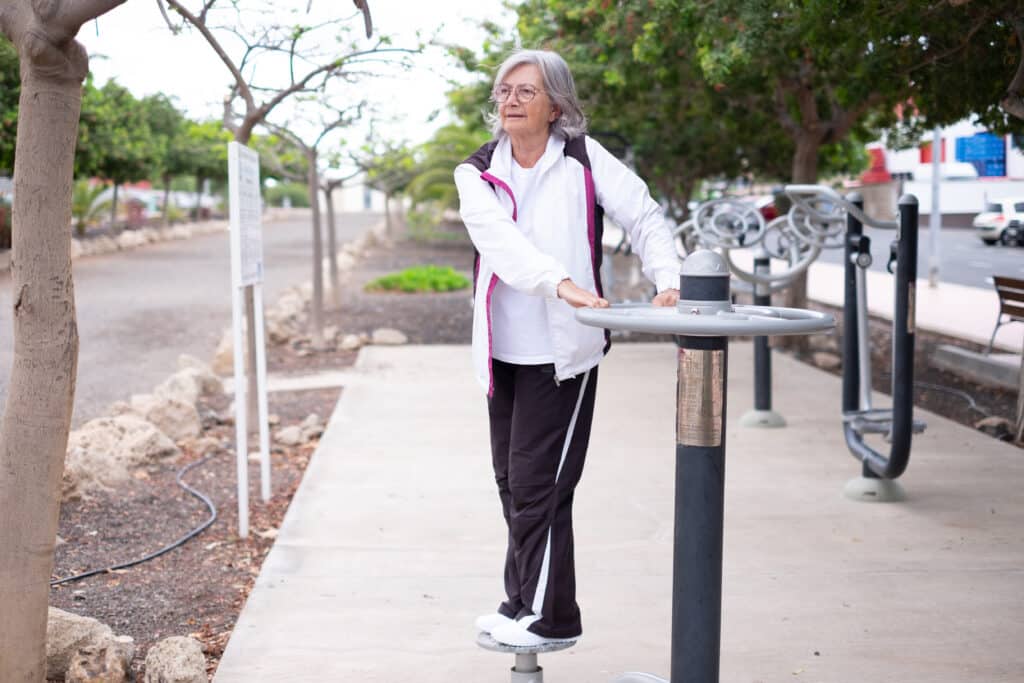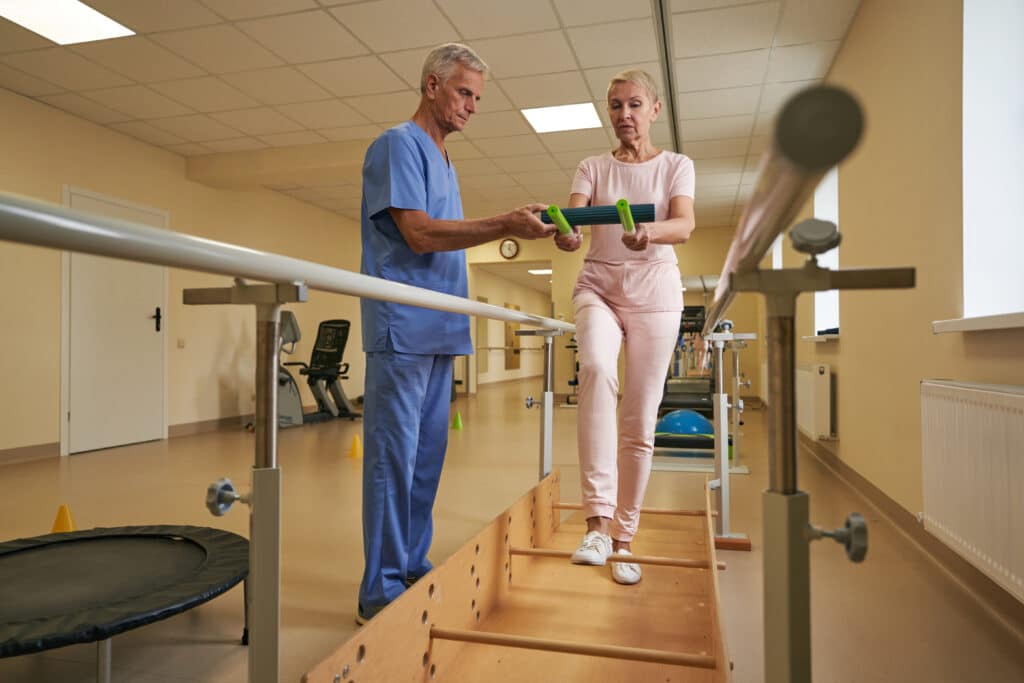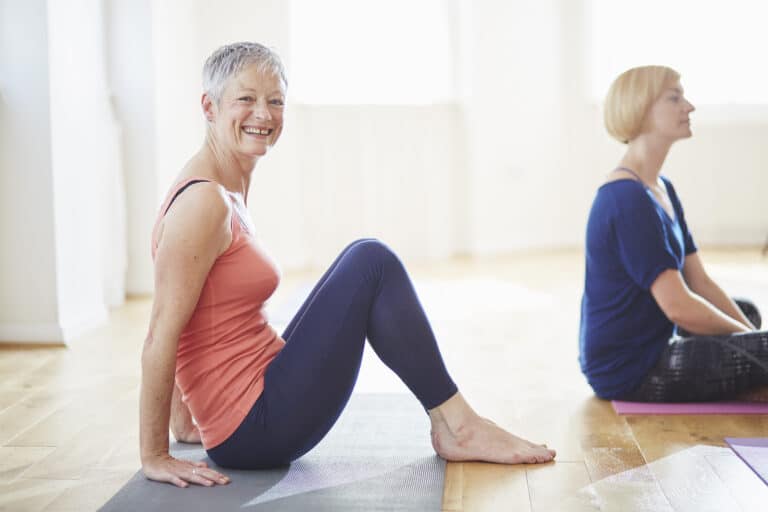Have you ever felt like you were leaning backward and couldn’t stand up straight? Backward disequilibrium (BD) is a condition that creates constant challenges, increasing the risk of falls and injuries for many older adults.
This condition affects your balance and can be caused by aging, neurological issues, or a combination of these things. By recognizing the symptoms early and seeking proper assessment, you can manage BD effectively.
With the right physical therapy, home adjustments, and safe daily practices, you can greatly reduce the risk of falls and regain your confidence.
This comprehensive guide will help you manage BD so you can feel steady and strong every day.
What is Backward Disequilibrium?
Imagine trying to walk straight while wearing glasses that make everything look tilted. Even though you know the ground is flat, your brain gets mixed signals, causing you to lean or stumble.
Similarly, when someone’s sense of what is upright is off, they might lean backward or sideways to compensate. This makes it hard to maintain balance, much like walking with distorted vision.
Backward disequilibrium (BD) is a condition where people have a noticeable backward-leaning posture and struggle to lean forward or stand fully upright. This makes them more likely to fall backward and get injured because their center of mass is always behind their base of support .1,2
Maintaining balance, whether standing still or moving, relies on three main systems:
- The visual system helps you stay centered by orienting to what you can see. For example, if the ground changes from flat to inclined, your brain tells your body to lean forward to keep from falling.
- The tactile system adjusts to different pressures under your feet depending on the surface or objects in your path or under your feet.
- The vestibular system in your head—specifically your inner ear—is influenced by gravity, and helps you know where your body is in space.
If any of these systems aren’t working properly, it can cause balance issues, such as backward disequilibrium, vertigo, and other similar conditions.
Why Backward Disequilibrium Happens

Backward disequilibrium occurs due to various factors, including age-related changes and neurological issues. Let’s take a look at how these factors can influence whether BD will become an issue for you or someone you know.
Age-Related Changes
As we age, our balance control systems typically begin to deteriorate. The vestibular system in the inner ear helps us maintain balance by sending signals to the brain about our head’s movements and position in space relative to these movements.
With aging, the number of vestibular hair cells responsible for balance and sensory perception can decrease by 20% to 40%, leading to reduced sensitivity and balance issues.3
Similarly, the visual system undergoes changes as we age. Decreased visual acuity, a narrowing of the visual field, and diminished depth perception make it harder to judge distances and navigate spaces safely.
Moreover, losses in contrast sensitivity can further impair our ability to see and react to our surroundings, making it difficult to gauge distances or spaces between objects accurately.
The somatosensory or tactile system, which includes sensations of pressures and textures from the skin, muscles, and joints, also declines with age. Nerve conduction velocity slows down, and sensory discrimination becomes less accurate.
These changes can affect proprioception, the body’s ability to sense its position in space, contributing to balance problems and postural issues.
Neurological Issues
In addition to these age-related changes, neurological conditions can significantly impact balance.
For instance, Parkinson’s disease affects the system that coordinates movement to maintain upright posture. This can lead to rigidity and a characteristic backward tilt of the trunk, commonly seen in Parkinson’s patients.
Similarly, the aftermath of a stroke can disrupt the brain’s ability to process information related to balance and postural stability, sometimes resulting in backward disequilibrium.2
Other conditions such as normal pressure hydrocephalus, which involves an accumulation of cerebrospinal fluid in the brain, and amyotrophic lateral sclerosis (ALS), which affects nerve cells controlling voluntary muscles, can also lead to backward disequilibrium.
Impact on Reflexes
Backward disequilibrium can also affect reflexes. Reflexes are automatic responses that help maintain posture and balance.
When the systems that control balance are impaired, reflexes may become slower or less effective, making it harder to correct a backward lean quickly. This delay can increase the risk of falls and injuries.
Understanding the wide variety of these contributing factors is crucial for diagnosing and managing backward disequilibrium.
What Backward Disequilibrium Feels Like

Living with backward disequilibrium can be incredibly challenging, both physically and mentally. Here’s a closer look at the everyday difficulties and the psychological impact this condition can have.
Everyday Challenges
Living with backward disequilibrium means facing constant challenges in maintaining balance and posture. People with this condition often find it difficult to stand or sit without feeling like they are falling backward or actually losing their balance.
Patients with this condition also have a very hard time going from sitting to standing because they can’t lean forward.
It’s like having a constant gentle push while trying to stand or walk, making even simple tasks daunting and exhausting.
Psychological Impact
The psychological toll of backward disequilibrium can be even more impactful for some people. Fear of falling, loss of confidence, and subsequent social withdrawal are commonly coupled with depression.
This fear and lack of movement can create a vicious cycle, where the anxiety about falling and resulting weakness makes the individual even more prone to falls.3
Getting Diagnosed
Recognizing and diagnosing backward disequilibrium early is essential for effectively managing and preventing falls. This involves understanding the symptoms and undergoing specific clinical assessments.
Recognizing the Symptoms
Backward disequilibrium is characterized by a distinctive backward-leaning posture that can be easily mistaken for poor posture or general weakness.
However, this condition specifically involves the center of mass shifting behind the base of support, causing falls almost exclusively in a posterior direction (falling backward).
If you or someone you know frequently leans backward while standing or sitting and experiences recurrent falls, these could be signs of backward disequilibrium.
The Importance of Recording Details of Occurences
Keeping a log of these incidents, including details about when and how they occur, can be incredibly helpful for healthcare providers in understanding the extent and pattern of the symptoms.
Awareness and early recognition of backward disequilibrium are vital for effective management. Noticing and documenting symptoms early on allows for timely intervention, which can prevent further complications and falls.
Regular discussions with a healthcare provider about any observed symptoms can lead to early diagnosis and a better treatment plan. This proactive approach can significantly improve the quality of life and autonomy for those affected by backward disequilibrium.
Clinical Assessment
Diagnosing backward disequilibrium involves more than just a general balance assessment. While conventional balance tests performed by your physical therapist evaluate overall balance and risk of falls, they do not specifically address the unique characteristics of backward disequilibrium.
A proper diagnosis requires detailed clinical observation in both static positions, like sitting and standing, and dynamic positions, such as during movement or walking.
Physical therapists and geriatricians play a crucial role in this process, utilizing their expertise to observe subtle cues and postural deviations that indicate backward disequilibrium.
In addition to standard balance tests, healthcare providers may employ specialized techniques to assess the subjective vertical, which is how an individual perceives uprightness. Misalignment in this perception is a hallmark symptom and can be a key diagnostic indicator.
Comprehensive assessments will frequently also include observing the patient’s ability to perform everyday tasks, such as getting up from a chair, in and out of a car, or walking across a room, to identify any backward tilting or instability.
Managing Backward Disequilibrium

Managing backward disequilibrium effectively requires a comprehensive approach, with physical therapy playing a key role. This often involves personalized programs designed to improve balance, strength, and functional abilities.
Physical Therapy
Physical therapy is a cornerstone in managing backward disequilibrium. This approach typically involves an individualized program including balance, strength, and functional training.
I always tell my patients to think of it as retraining their body’s balance system, much like relearning to ride a bike after a long hiatus—the foundational knowledge is there, but the steps to get there might feel a little fuzzy.
Through a series of progressive resistance exercises and balance-enhancing activities, physical therapy aims to rebuild the muscle strength and coordination necessary for maintaining stability.
These exercises can help realign the body’s center of mass, reducing the tendency to lean backward, thereby decreasing the risk of falls.
Progressive Resistance and Balance Training
Progressive resistance training is particularly beneficial as it helps build muscle strength and endurance.
Coupled with balance exercises, this type of training can significantly enhance overall stability. For instance, activities that challenge your balance, such as standing on one leg or using balance boards, can improve proprioception and postural control.
Balance boards can also help by providing a dynamic surface that challenges balance and helps you learn to adjust your posture.
Note: if you’re already balance-challenged, it’s best to seek the advice of a physical therapist before using balance boards or other de-stabilizing devices.
Functional training, which focuses on everyday activities like standing up from a chair or walking, also plays a crucial role.
Using mirrors during therapy can provide visual feedback, helping patients understand and correct their posture in real-time. This immediate visual cue can reinforce proper alignment and balance techniques.
One of my favorite functional exercises to practice with these patients is floor transfers. These exercises allow patients to get up from the ground safely after a fall. Their complexity also makes them great whole-body exercises for muscle strengthening, weight shifting, and balance training.
A Team Approach for Best Results
By practicing these movements under the guidance of a physical therapist, individuals can develop safer movement patterns and improve their confidence in performing daily tasks.
Effective management of backward disequilibrium requires a team approach. This team typically includes physical therapists, doctors, psychologists, and caregivers.
Each professional brings their expertise to address different aspects of the condition.
Preventing Falls and Improving Safety
Preventing falls and improving safety for those with backward disequilibrium involves making home modifications and adopting safe daily practices. These changes can greatly reduce the risk of falls and enhance overall confidence.
Home Modifications
Creating a safer home environment is essential to managing the risk of falls due to backward disequilibrium. I recommend this as one of the first things I do for my patients with balance issues.
Practical adjustments can significantly reduce the risk of falls. For instance, installing grab bars in key areas such as the bathroom can provide support when moving in and out of the shower or using the toilet.
Using non-slip mats in areas prone to water spills, like the kitchen and bathroom, can prevent slips. Removing tripping hazards such as loose throw rugs, clutter, and electrical cords from walkways can create a safer space for moving around.
Additionally, ensuring that your home is well-lit, especially in hallways and staircases, can help you navigate more safely.
Home modifications are a proactive step toward fall prevention. Simple changes, like rearranging furniture to create clear pathways or using furniture with sturdy armrests for additional support when standing or sitting, can make a big difference.
These adjustments help prevent falls and provide peace of mind, allowing you to move around your home more confidently and easily. Consulting with an occupational therapist can provide valuable insights and recommendations tailored to your specific needs and living environment.
Daily Practices
Incorporating safe practices into your daily routine is another effective strategy for managing backward disequilibrium.
I often suggest to my patients that they wear supportive footwear with good grip and stability to enhance balance and reduce the risk of slipping.
If necessary, using mobility aids such as canes or walkers can provide additional support. Practicing safe movement techniques is important, like standing up slowly to avoid dizziness or holding onto stable surfaces when moving.
These small adjustments can significantly impact your stability and confidence. For instance, taking the time to move carefully and deliberately rather than rushing can help you maintain better control over your movements.
Practicing exercises that improve your core strength and flexibility can also contribute to better balance.
By integrating these practices into your daily routine, you can work to manage your backward disequilibrium.
Key Takeaways
- Backward disequilibrium (BD) is when people lean backward too much, making it hard to lean forward or stand upright, leading to a higher risk of falling backward.
- Balance relies on visual, postural, and tactile systems. Problems with these systems can cause balance issues, making people feel like they are falling backward and struggling with sitting and standing.
- BD can be caused by age-related changes in the vestibular, visual, and tactile systems, or neurological conditions like Parkinson’s disease, strokes, normal pressure hydrocephalus, and ALS.
- BD affects reflexes, making it harder to correct a backward lean quickly, increasing the risk of falls.
- People with BD face challenges in maintaining balance and posture, feeling pushed backward, and having difficulty standing or sitting. This can lead to fear of falling, depression, loss of confidence, and social withdrawal.
- Early recognition and clinical assessment are essential for managing BD. These involve noting backward-leaning posture and frequent falls and keeping a log of incidents to help healthcare providers.
- Physical therapy is crucial. It involves balance training, strength training, and functional training, with exercises like using balance boards and mirrors to improve stability and posture.
- Effective management requires a team approach involving physical therapists, doctors, psychologists, and caregivers.
- Home modifications can reduce fall risks by installing grab bars, using non-slip mats, removing tripping hazards, and ensuring good lighting.
- Safe daily practices, such as wearing supportive footwear, using mobility aids, and moving carefully, can improve stability and confidence.
References
- Scheets, P. L., Sahrmann, S. A., Norton, B. J., Stith, J. S., & Crowner, B. E. (2015). What is backward disequilibrium and how do I treat it?: A complex patient case study. Journal of Neurologic Physical Therapy, 39(2), 119-126.
- Manckoundia, P., Mourey, F., Pfitzenmeyer, P., Van Hoecke, J., & Pérennou, D. (2007). Is backward disequilibrium in the elderly caused by an abnormal perception of verticality? A pilot study. Clinical neurophysiology, 118(4), 786-793.
- Manckoundia, P., Mourey, F., Pérennou, D., & Pfitzenmeyer, P. (2008). Backward disequilibrium in elderly subjects. Clinical interventions in aging, 3(4), 667-672.






